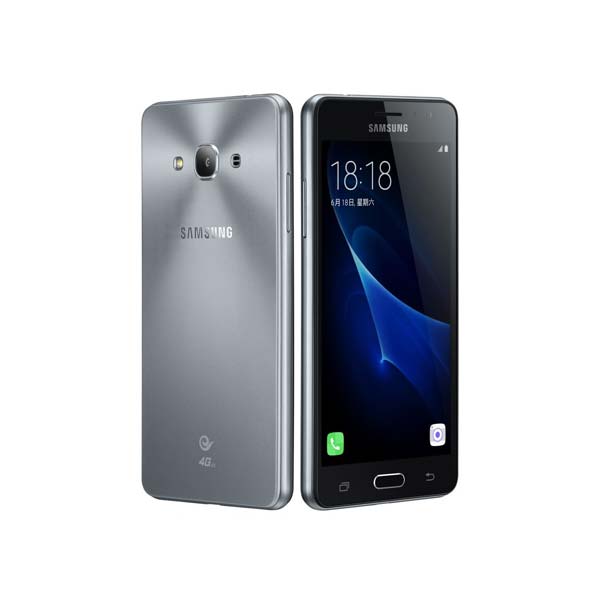
 Out of stock
Deactivated
Out of stock
Deactivated
 13,999
13,999
 Out of stock
15,790
Out of stock
15,790
 In stock
16,500
In stock
16,500
 21,990
21,990
Samsung Galaxy J3 Pro is a budget phone from Samsung. Pakistani market is full of budget smartphone brands like Xiaomi and Infinix. Samsung might face a tough time selling this phone in Pakistan. This phone is for those people (Samsung fans) who want a Samsung phone at less price. The J3 Pro comes with decent specifications at this price tag. You can also explore prices of Samsung mobile phones in the same specifications bracket.
The Galaxy J3 Pro has a uniform design overall. It has a more rectangular form factor than the J3 2016. The phone has a flat, removable back made up of plastic. A 3.5mm headphone jack is present at the top.
The power button is located on the right side and the volume rocker on the opposite side. The bottom of the device has a Micro-USB port for data transfer and charging. A fingerprint scanner is embedded in the home button for easier access. Overall, the phone can be used with one hand easily.
The phone has a 5.0 inch Super AMOLED display with a resolution of 1280 x 720, which is good enough for a low-end smartphone.
You might also want to check:
The Samsung J3 Pro has an 8 MP, f/2.2 main camera with autofocus and a single LED flash. The front camera is a 5 MP, f/2.2 unit. Main camera can record 1080p videos at 30fps.
The main camera takes excellent photos in daylight but performs terribly in low light shooting for obvious reasons. Video quality goes in the same category, it records excellent videos daylight and struggles in low light conditions. Shakes and jitters are very apparent in video recording.
Front facing selfie camera is also decent and thanks to Samsung’s post processing software which makes the selfies look better by softening them. Overall, it has a decent camera. What else do you expect from a phone at this price range?
The Samsung Galaxy J3 Pro comes with a Snapdragon 410 chipset with Quadcore 1.2 GHz Cortex-A53 CPU, which might seem a bit weak as compared to other competitive devices like Huawei P10 Lite, but it performs good enough in everyday tasks. The RAM is 2 GB which is good enough for a lag free performance. The phone does a decent job in performing general, everyday tasks like taking photos, using social media apps, playing some basic games and general multitasking. However, it falls short on heavy multitasking and running the graphic demanding games like Injustice: Gods Among Us and Mortal Kombat X.
| Device Type | SmartPhone |
| Announced | 03 June, 2016 |
| Released | 17 June, 2016 |
| Status | Available |
| Price | 13,999 PKR |
| Type Design Type called form factor refers to a mobile phone's size, shape, and style as well as the layout and position of major components of phone. There are three major form factors seen in mobile phones => bar phones, folding phones and sliding phones. | Bar |
| Dimensions | 142.2 x 71.3 x 8 mm (5.60 x 2.81 x 0.31 in) |
| Weight | 139 g (4.90 oz) |
| Colors |
White, Black, Gold |
| SIM SIM (Subscriber Identity Module) is a small card that contains mobile network subscriber's account information. This allows the phone using the card to attach to a mobile network. The SIM card is most commonly associated with GSM and UMTS mobile networks. Moving a SIM card from one phone to another allows a subscriber to switch mobile phones without having to contact their mobile network carrier. SIM cards can also be used by a phone to store limited amounts of data, such as phone numbers and text messages. | Micro SIM |
| Dual SIM | yes |
| Display Type Display Technology => A number of display technologies and types used in mobile phones => TFT (Thin Film Transistor), IPS (In-Place Switching), OLED (Organic Light Emitting Diode), AMOLED (Active-Matrix Organic Light-Emitting Diode), Super AMOLED (an even advanced version of AMOLED), Resistive Touchscreen (Resistive touchscreens contain two layer of conductive material with a very small gap between them which acts as a resistance), Capacitive Touchsceen (Capacitive touchscreen technology consists of a layer of glass coated with a transparent conductor) | Super AMOLED capacitive touchscreen |
| Size | 5.0 inches |
| Resolution | 720 x 1280 pixels |
| Display Colors Display Colors is refers to the number of different shades of colors that the screen is capable of displaying => 64K colors, 256K colors and 16 million colors, Obviously 16M is highest available range of colors and better than others. | 16M colors |
| Pixel Density Pixel Density (PPI) is refers to the concentration of pixels on a particular display, measured in pixels per inch (ppi). Pixel density is calculated by dividing the diagonal pixel resolution of a display by its diagonal size, higher pixel density better display quality. | 294 ppi pixel density |
| Touch Screen | capacitive touchscreen |
| Features | multitouch |
| Primary Camera is able to capture photographs and usually videos, The most important characteristics of a camera are the resolution (measured in megapixels), lens focus type (fixed or automatic), higher megapixel cameras are known to capture higher quality photos, but not always a good measurement of the photos quality. | 8 MP, f/2.2, autofocus |
| Video | 1080p@30fps |
| Camera Features |
Geo-tagging, touch focus, face detection, HDR |
| Flash Flash Light => There is commonly two types of flash lights are used in camera mobile phones, LED Flash (LED flash offers lower power consumption with drive circuitry that takes up very little room, LEDs can be strobed faster than any other light source), Xenon Flash (xenon flash produces an extremely intense full-spectrum white light for a very short duration) | LED flash |
| Secondary | 5 MP, f/2.2 |
| Operating System OS => Every computer system run on a base software called Operating System (OS). Operating System controls all basic operations of the computer (such as smartphone, PDAs, tablet computers and other handheld devices). The Operating System allows the user to install and run third party applications (apps), apps are used to add new functionality to the device. | Android 5.1 (Lollipop) |
| Chipset Chipset is a group of integrated circuits designed to perform one or a more dedicated functions, often with real time computing constraints, Popular smartphones are equipped with more advanced embedded chipsets that can do many different tasks depending on their programming. | Qualcomm MSM8916 Snapdragon 410 - J3119 |
| CPU CPU (Central Processing Unit) mostly known as processors, CPU processes instructions in order to carry out certain functions that make your device operate properly. Processors are often described as the brain of computers, smartphones and tablets, Smartphones and tablets rely on processors to carry out their every task, Processors are an incredibly important factor in selecting any type of computing device, including your smartphone. | Quad-core 1.2 GHz Cortex-A53 |
| GPU GPU (Graphics Processing Unit) is a single-chip processor designed to rapidly manipulate and alter memory to accelerate the creation of images in a frame buffer intended for output to a display, This includes things such as lighting effects, object transformations, and 3D motion. | Adreno 306 |
| RAM (Memory) RAM (Random Access Memory) is a type of computer memory that can be accessed randomly, any byte of memory can be accessed without touching the preceding bytes that allows information to be stored and accessed quickly from random locations. RAM is the most common type of memory found in computer systems, smartphones, tablets and other electronic devices. | 2 GB RAM |
| Internal Storage Internal Storage is a data storage space (flash memory) mostly used in smartphones, tablets and other electronic devices where operating system, apps, music, photos, videos, files and other user data Is stored. | 16 GB |
| Card Slot Memory Card Slot is a special slot for inserting a memory card. Memory cards allow you to expand the phone's built-in memory, A memory card (sometimes called a flash memory card or a storage card) is a small storage medium used to store data such as text, pictures, audio, and video, for use on small, portable or remote computing devices such as mobile phones, mp3 players, digital cameras. | microSD, up to 256 GB (dedicated slot) |
| Sensors Sensors are electronic components that detects and responds to some type of input from the physical environment. The specific input could be light, heat, motion, moisture, pressure and location, The output is generally a signal that is converted to use in computing systems, a location sensor, such as a GPS receiver is able to detect current location of your electronic device. |
Accelerometer, proximity |
| Bluetooth Bluetooth is a wireless communications technology for exchanging data between mobile phones, headsets, computers and other network devices over short distances without wires, Bluetooth technology was primarily designed to support simple wireless networking of personal consumer devices. | 4.1, A2DP |
| Wi-fi Wi-Fi is a popular wireless networking technology using radio waves to provide high-speed network connections that allows devices to communicate without cords or cables, Wi-Fi is increasingly becoming the preferred mode of internet connectivity all over the world. | yes |
| GPS GPS The Global Positioning System is a satellite-based radio navigation system, GPS permits users to determine their position, velocity and the time 24 hours a day, in all weather, anywhere in the world, In order to locate your position, your device or GPS receiver must have a clear view of the sky. | yes |
| NFC NFC (Near field communication) is a set of standards for smartphones and similar devices to establish peer-to-peer radio communications with each other by touching them together or bringing them into proximity, usually no more than a few inches. | |
| Card Reader | |
| Headphone Jack | |
| Microphone Jack |
| GPRS GPRS (General Packet Radio Service) is a packet oriented mobile data service on the 2G and 3G cellular communication system's global system for mobile communications (GSM), Generally, GPRS is used for the purpose of wireless data transfer, such as sharing pictures and videos or browsing the Internet via a mobile phone connection. | |
| EDGE EDGE (Enhanced Data GSM Environment) is a wireless network technology generally considered the next step in the 2G network offers data transfer rates up to four times faster than ordinary GSM networks, Generally, EDGE is used for the purpose of wireless data transfer, such as sharing pictures and videos or browsing the Internet via a mobile phone connection. |
| Battery Type Battery Type => Cell phones run on various kinds of batteries depending on the manufacturer, phone size or shape and features. There are basically four types of cell phone batteries => Lithium Polymer, Lithium Ion, Nickel Metal Hydride and Nickel Cadmium. | Li-Ion (Lithium Ion) |
| Capacity Battery Capacity is a measure (typically in Amp-hr) of the charge stored by the battery, and is determined by the mass of active material contained in the battery. The battery capacity represents the maximum amount of energy that can be extracted from the battery under certain conditions. | 2600 mAh battery |
| Placement | Removable Li-Ion |
| Standby Standby Time is the total amount of time that you can leave your is fully charged, turned on and ready to send and receive calls or data transmissions before completely discharging the battery. | upto 350 h |
| Talk Time Talk Time is the longest time that a single battery charge will last when you are constantly talking on the phone under perfect conditions, Ambient temperature and highly dependent on the cellular network environment such as the distance to the closest cell network tower. | upto 7h |